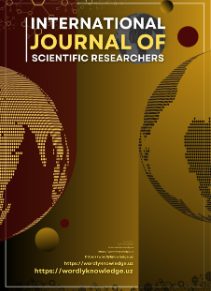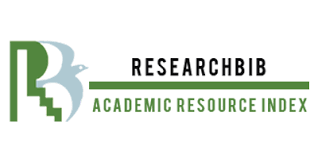ON THE CALCULATION OF A MODEL OF A THREE-DIMENSIONAL TURBULENT DIFFUSION PLUME
Abstract
Problems with environmental pollution, improving and increasing the efficiency of burning natural gas is a global urgent task.
In the works of Academician Ya.B. Zeldovich and N. Semenov, topical and currently questions on the theory of combustion of unmixed gases, the kinetics of chemical reactions in flames , on the theory of flame propagation and their limits, and on the ignition of gases have found their development.
The organization of the combustion process with a separate supply of fuel and oxidizer is very typical for the technology of furnace practice. The simplest type of such process is the diffusion flame. The main position of this theory is the assumption of the generality of the transfer mechanism in turbulent jets and a burning flame. All this makes it possible to apply the mathematical apparatus for calculating turbulent flows in solving the problem of burning a diffusion flame. In this case, the location of the flame front is determined from the condition that the reactant flows approaching the flame front are in stoichiometric ratio. In this paper, a three-dimensional model of diffusion combustion is presented in the case of the outflow of a combustible gas mixture from a rectangular nozzle and propagating in a heated (with a passing) air flow. For the three-dimensional case, the transformation of the multicomponent concentration equation is described in detail using the conservative Schwab-Zeldovich function with respect to excess concentrations, which reduces the number of diffusion equations to one for a four-component mixture. It is assumed that on the surface of the flame front, the flows of the oxidizer and fuel must satisfy the condition of stoichiometric equality of the consumed and formed substances at the flame front are equal to zero.
The three-dimensional system of Navier-Stokes equations is used to describe the flow.
To calculate the turbulent viscosity, an algebraic model is used that takes into account the three-dimensionality and temperature inhomogeneity of the jet. A number of numerical results are given as the influence of the initial value of the velocity of the combustible mixture on the flame parameters. During diffusion combustion of a propane-butane mixture. It was found that an increase in fuel velocity does not always lead to an increase in the maximum temperature at the flame front, with other parameters unchanged.
References
1.Ya.B. Zel'dovich On the theory of combustion of undisplaced gases.
// Journal of Technical Physics, V.19., Issue 10, 1949, p. 107-114.
2.V. Gauthorn , D. Widdel , G. Hottell Mixing and combustion in turbulent gas jets. // Sat. Questions of combustion, V.1, - M: Ed. inost . lit., 1953, p. 124-145.
3.Madney , Pletcher . Calculation of forced turbulent updrafts in stratified and homogeneous environments. Gr. Amer. islands. eng . mech., ser. Heat transfer, 1977, N 1, p.105.
4.L.A. Vulis, L.P. Yarin Torch aerodynamics. –L.: Energy. 1978. , -216 p.
5.A.V. Shvab Connection between temperature velocity models of a gas torch. // Sat. “Research on natural fuel combustion processes”. Under . ed. G.F. Knorre , State Energy Publishing House . 1948.
6.V.I. Vasiliev, L.G. Golubtsova , S.Yu. Krasheninnikov, Yu.A. Rudy Study of the propagation of three-dimensional turbulent jets. //Materials of the 5th All-Union. congress on theory. and appl. mechanics. Alma-ata, May 27-June 3, 1981. Abstract report . Alma - ata , 1981, pp. 87-88.
7.NCG Markatos , A. Moult The computation of steady and Unsteady, turbulent, chemically reacting flaus in axi symmetrical demains. Trans lnst . chem. Eng. 1979, 57, N3, P. 156-162. // RFJ 1980, 1, 1599.
8.MH Carpenter Three – Dimensional Computation of cross-flow lnjection and Combustion in a Supersonic flow. // AIAA Paper-1989, N 1970, p. 1-16.
9.S.I. Isataev , G. Toleuov , M.S. Isataev . Investigation of the average characteristics of three-dimensional turbulent jets eLIBRARY ID .44757673. Bulletin of the Cossack National University. Physical series. No. 2 (41) 2012. c. 54-60 .
10.S. Khodjiev , Sh.S. Yuldashev, S.A. Makhmudov. Investigation of the initial sections of free turbulent jets flowing from rectangular nozzles. Uzbek magazine. Problems of mechanics. FAN. Academy of Sciences of the Republic of Uzbekistan - Tashkent, 1992. With. 64-68.
11.S. Khojiev,Sh.S. Yuldoshev, Sh.Sh.Savriev, A.S.Мurtazoyev Numerical simulation of three-dimensional turbulent jets of reacting gases Eurasian journal of mathematical theory and computer sciences. Innovative Academy Research Support Center, Volume 2 Issue 6, June 2022, ISSN 2181-2861, pages 73-82, www.in-academy.uz, https://doi.org/10.5281/zenodo.6778321.
12.S. Khodjiev , A.Kh. Avezov , Sh. Murodov Numerical modeling of three-dimensional turbulent jets of reacting gases flowing out of a rectangular nozzle based on the “k- ” turbulence model. Scientific journal Bulletin of the Bukhara State. University. Bukhoro 2007. N 3 p . 81-87.
13. S. Khodjiev , Z.Sh. Zhumaev, A. Primov , Z.A. Muminova. Investigation of three-dimensional turbulent jets of reacting gas flowing from a rectangular nozzle and propagating in a cocurrent (flooded) air flow during diffusion combustion Uzbek journal “Problems of Mechanics” – Tashkent FAN. AN. Republic of Uzbekistan, 1993. pp. 28-33.
14.Yu.V. Lapin, M.Kh. Sterelec . Internal flows of gas mixtures.
The science . Editor-in-Chief, Physics and Mathematics , 1989-368 p.
15.D. Anderson, J. Tannehill , R. Pletcher . Computational fluid mechanics and heat transfer. In 2 T . T.2: Per. From English : Mir, 1990, -728-392.







